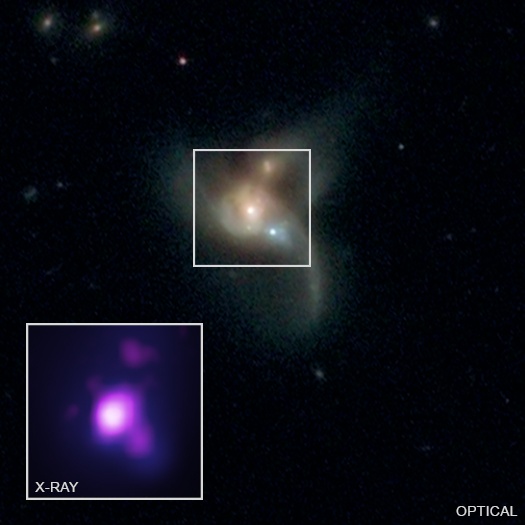What’s better than two gigantic galaxies swirling into one another until they collide? How about three galaxies swirling into one another until they collide – and they all have supermassive black holes at their core to boot! Recently, a team led by Dr. Adi Foord of Stanford combed through data from the WISE mission and the Sloan Digital Sky Survey to search for instances of three galaxies colliding with one another. In all that data, they managed to find 7 separate systems that met those criteria.
The systems in question ranged between 370 million and one billion light years away, so any light coming from them is obviously very difficult to detect. Specifically the team was most interested in whether the systems had supermassive black holes in them, and if they did, how many they had. X-rays are the wavelength most descriptive of black hole interactions due to their ability to detect material being absorbed into the black hole (and being heated to millions of degrees in the process). The Chandra X-ray observatory was used to observe these seven systems. The team was most interested in whether or not the supermassive black holes potentially at the center of these galaxies merged together.
A merger of supermassive black holes would be interesting to scientists, as it so far has not been witnessed directly, and there is some speculation that it is in fact impossible for two supermassive black holes to get close enough to one another to effectively merge. If they do in fact merge, there is the additional question of whether they emit gravitational waves, as have been first detected for stellar-sized black holes not long ago.
There is a chance both that they do not merge together at all, and then that they do not produce gravitational waves if they do. In such a “nightmare scenario”, as paper author Michael Koss of Eureka Scientific puts it, gravitational wave detectors such as LIGO would never be able to study the merger of two supermassive black holes.

Credit: NASA/CXC/George Mason Univ/ R. Pfeifle et all / SDSS / STSci
The theory surrounding the merger of these colossal objects states that if there are only two in a system, they might not be able to get close enough to each other to merge. However, adding a third black hole to the system, such as one at the center of a third galaxy, can destabilize the system, allowing two or more to merge, in a supermassive version of the three-body problem.
What they found was a mix of outcomes ranging from a system with three separate black holes still existing to a system with no x-ray emissions from black holes at all. Other results included four systems with two growing supermassive black holes, and one that had a single supermassive black hole in it.
It’s not clear yet what these findings will mean for understanding the further growth and evolution of black holes in such extreme environments as a trifecta or merging galaxies. But as we continue to collect and archive more data about the universe, algorithms like that one used to pull the data together for this paper will become all the more useful.
Learn More:
NASA/CXC: Galaxies Hit Single, Doubles, and a Triple (Growing Black Holes)
EarthSky: Found: 3 black holes due to collide
arXiv: AGN Triality of Triple Mergers: Detection of Faint X-ray Point Sources
Feature Image Credit: NASA / CSC / UofM / A. Foord et al / SDSS / STSci

